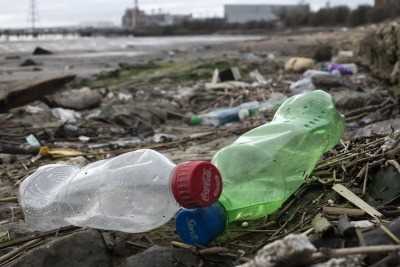
Plastic is a ubiquitous material in our modern world. From packaging to toys to medical devices, plastic is used in a wide range of applications. But have you ever wondered how this versatile material got its name?
The term “plastic” actually comes from the Greek word “plastikos,” which means “capable of being shaped or molded.” This aptly describes the nature of plastic, as it can be molded into various forms and shapes when heated or under pressure.
However, it was not until the 19th century that the term “plastic” began to be used to refer to a specific material. In 1907, Leo Hendrik Baekeland, a Belgian-American chemist, invented Bakelite, the first synthetic plastic. Baekeland’s invention revolutionized the manufacturing industry and paved the way for the development of countless other plastic materials.
The term “plastic” was soon adopted to describe not only Bakelite but also other synthetic materials that shared similar properties. Today, “plastic” is used to refer to a vast array of materials, including polyethylene, polystyrene, and PVC, among many others.
- The Beginning of Plastic
- The Search for a Name for the Revolutionary Material
- The Impact of the Name
- A Lasting Legacy
- Plastic: A New Era in Materials
- Advantages of Plastic
- Environmental Impact of Plastic
- The Origin of the Term “Plastic”
- Evolution of the Term “Plastic”
- Impact and Significance of the Term “Plastic”
- The Mastermind behind the Name
- The Impact and Legacy of the Term “Plastic”
- Innovation and Adaptability
- Environmental Concerns
- Q&A:
- Who invented the term “plastic”?
- Why did Alexander Parkes come up with the name “plastic”?
- What does the term “plastic” mean?
- Has the definition of the term “plastic” changed since it was first coined?
The Beginning of Plastic
Plastic is a material that is now an integral part of our daily lives. From the packaging of food and drinks to the construction of cars and buildings, plastic is everywhere. But where did it all begin?
The origins of plastic can be traced back to the mid-19th century. In 1869, an American inventor named John Wesley Hyatt developed the first synthetic plastic. He was trying to find a substitute for ivory, which was becoming scarce due to the high demand for billiard balls. Hyatt combined cellulose, a natural polymer found in plants, with camphor, a substance extracted from tree bark, to create a hard yet moldable material.
This new material was named “celluloid” and quickly gained popularity for a variety of applications. It was used to make not only billiard balls but also combs, buttons, and photographic film. Celluloid was hailed as the “ivory of the industry” due to its resemblance to the real thing.
The success of celluloid led to further experimentation and the development of new types of plastic. In the early 20th century, chemists discovered ways to create synthetic polymers by manipulating molecules and bonding them together in various ways. This paved the way for the production of different types of plastics with varying properties and uses.
One significant milestone in the history of plastic was the invention of Bakelite in 1907 by Belgian-born American chemist Leo Hendrik Baekeland. Bakelite was the first completely synthetic plastic made from a combination of phenol and formaldehyde. It was a heat-resistant and durable material that found wide applications in electrical insulators, telephones, and even jewelry.
As the years went by, advancements in technology and chemistry led to the creation of numerous other types of plastics. From polyethylene to polystyrene, each plastic has its own unique characteristics, making it suitable for specific applications.
Today, plastic is an integral part of our modern world. Its versatility, durability, and low cost have made it the go-to material for countless products. However, the environmental impact of plastic waste has become a growing concern. Efforts are being made to reduce plastic consumption and develop more sustainable alternatives. Nevertheless, the story of plastic and its contributions to society cannot be ignored.
The Search for a Name for the Revolutionary Material
When Leo Hendrik Baekeland invented the first fully synthetic plastic, he faced the challenge of finding a fitting name for his groundbreaking creation. He knew that the name had to capture the essence of this new material and convey its revolutionary nature.
Baekeland began his search by looking at the properties of the material. He noted that it was malleable, durable, and could be molded into various shapes. He also observed that it was resistant to heat and chemicals, making it an ideal material for a wide range of applications.
Recognizing the transformative nature of his invention, Baekeland wanted a name that would reflect its versatility and potential to revolutionize industries. He sought a term that would encapsulate its ability to be molded into different forms and its ability to adapt to various settings.
After weeks of contemplation and numerous discussions with colleagues, Baekeland finally settled on the name “plastic.” The term derived from the Greek word “plastikos,” which means “capable of being shaped or molded.” It perfectly captured the essence of the material and conveyed its unique properties.
The Impact of the Name
The word “plastic” quickly caught on, becoming synonymous with the revolutionary material invented by Baekeland. Its simplicity and clarity made it easily understandable for both scientists and the general public.
The choice of the name “plastic” also contributed to the material’s widespread adoption and commercial success. The term conveyed the material’s potential for innovation and opened up a world of possibilities for its application in various industries.
A Lasting Legacy
The name “plastic” has since become a common term, used to describe a wide range of synthetic materials that are malleable and capable of being molded into different shapes. It has become ingrained in our everyday language and has come to represent the versatility and adaptability of these materials.
Today, plastic is ubiquitous in our society, and it plays a vital role in many different industries. From packaging and construction to electronics and healthcare, plastic has revolutionized the way we live and work.
The ingenuity of Leo Hendrik Baekeland in not only inventing the first fully synthetic plastic but also in finding the perfect name for it has left a lasting legacy. The term “plastic” will forever be associated with this revolutionary material that has shaped our modern world.
Plastic: A New Era in Materials
Plastic is a revolutionary material that has transformed many aspects of our lives. It has become an integral part of our everyday existence, from the objects we use to the packaging that protects our food and goods.
Plastic is a versatile substance that can be molded into almost any shape, making it ideal for a wide range of applications. It is lightweight, durable, and has excellent strength-to-weight ratio, making it an ideal choice for transportation and construction industries.
The history of plastic can be traced back to the early 20th century, when chemists began experimenting with different materials and processes to create a new type of material. The term “plastic” was coined to describe this new class of materials that could be molded and shaped.
Advantages of Plastic
The advent of plastic has brought numerous advantages to society. One of the biggest advantages is its ability to be mass-produced at a relatively low cost. This has made it accessible to people from all walks of life, revolutionizing industries such as consumer goods, healthcare, and electronics.
Plastic also offers a wide range of properties that make it suitable for various applications. It can be transparent or opaque, rigid or flexible, and can be engineered to have specific material properties such as heat resistance, chemical resistance, and electrical conductivity.
Environmental Impact of Plastic
While plastic has undoubtedly revolutionized many industries, it also comes with certain environmental challenges. The durability and resistance of plastic to natural degradation mean that it can persist in the environment for hundreds of years.
Plastic waste has become a global issue, with millions of tons of plastic ending up in landfills and oceans every year. Efforts are being made to reduce single-use plastics and develop more sustainable alternatives, such as biodegradable plastics made from renewable resources.
| Advantages of Plastic | Environmental Impact of Plastic |
|---|---|
| Mass production at low cost | Long-lasting in the environment |
| Wide range of properties | Plastic waste in landfills and oceans |
| Revolutionized industries | Efforts to reduce single-use plastics |
Plastic has undoubtedly ushered in a new era in materials, revolutionizing industries, and shaping the way we live. While it comes with its own set of challenges, the ongoing innovation and development in the field of plastic materials offer hope for a more sustainable future.
The Origin of the Term “Plastic”
The term “plastic” was coined in the early 19th century and has its roots in the Greek word “plastikos”, which means “capable of being shaped or molded.” It was first used to describe certain materials that were malleable and could be molded into different forms.
In 1862, the Parkesine Company, founded by Alexander Parkes, introduced the first man-made plastic material. Parkesine, also known as celluloid, was derived from a mixture of cellulose and camphor. This marked a significant development in the history of plastics, as it became the foundation for many other forms of plastic materials we use today.
However, it was not until the early 20th century that the term “plastic” became widely used to describe a whole class of synthetic materials. The invention and commercialization of Bakelite, the first true synthetic plastic, in 1907 by Leo Baekeland played a key role in popularizing the term.
Evolution of the Term “Plastic”

Over time, the term “plastic” expanded to encompass a broader range of materials with different properties and characteristics. Today, plastics are classified into various categories based on their chemical composition and physical properties. These include thermoplastics, thermosetting plastics, and elastomers.
Impact and Significance of the Term “Plastic”
The term “plastic” has become synonymous with versatility and adaptability. It highlights the ability of these materials to be molded, shaped, and transformed into various products, making them indispensable to modern life. From packaging materials to medical devices, plastic has revolutionized numerous industries and has had a profound impact on our everyday lives.
| Year | Development |
|---|---|
| 1862 | Introduction of Parkesine, the first man-made plastic |
| 1907 | Invention of Bakelite, the first true synthetic plastic |
The Mastermind behind the Name
It was in 1907 when the term “plastic” was first introduced to describe a variety of synthetic materials with the ability to be molded into various shapes and forms. But who was the mastermind behind the name?
The credit goes to Leo Hendrik Baekeland, a Belgian-born American chemist and inventor. Baekeland, who is widely recognized as the “father of the plastics industry,” coined the term “plastic” to describe one of his most significant inventions – Bakelite.
Bakelite was the first truly synthetic plastic, and it revolutionized the manufacturing industry with its remarkable properties. Baekeland developed Bakelite by mixing phenol and formaldehyde under high heat and pressure. The result was a hard, durable, heat-resistant material that could be molded into any desired shape.
In naming his invention, Baekeland drew inspiration from the Greek word “plastikos,” meaning “capable of being shaped or molded.” This term aptly described the material’s ability to take on any form during manufacturing.
Baekeland’s new material caught the attention of various industries due to its versatility and practicality. Bakelite quickly became widely used in electrical insulation, automotive parts, and consumer goods. The term “plastic” gained popularity and was soon used to describe a whole family of synthetic materials with similar properties.
Today, “plastic” is a widely recognized term that is used to describe a vast range of materials that have shaped our modern world. Thanks to the ingenuity of Leo Baekeland and his invention of Bakelite, the term “plastic” has become synonymous with durability, versatility, and innovation.
The Impact and Legacy of the Term “Plastic”
The term “plastic” has had a profound impact on the world and has left a lasting legacy. Initially coined by the chemist Leo Hendrik Baekeland in the early 20th century, the term “plastic” has come to represent much more than just a material. It has become synonymous with adaptability, versatility, and innovation.
Plastics have revolutionized various industries, such as packaging, construction, manufacturing, and healthcare. The introduction of plastics has enabled the development of new and improved products, making our lives more convenient and efficient.
Innovation and Adaptability
The term “plastic” embodies the concept of being able to mold or shape something to fit different needs. This quality has opened up limitless possibilities for design and engineering. Plastics can be molded into complex shapes, allowing for intricate detailing and customization.
Plastics also possess a wide range of properties, such as durability, lightweight, flexibility, and resistance to chemicals. This versatility has made plastic the material of choice in countless applications, from everyday household items to advanced medical devices.
Environmental Concerns
While plastics have brought numerous benefits, they have also presented significant environmental challenges. The durability of plastics means that they persist in the environment for a long time, leading to pollution and waste accumulation.
Plastic pollution poses a threat to marine life, with millions of tons of plastic waste ending up in our oceans each year. This has prompted increased efforts to reduce single-use plastics and develop more sustainable alternatives.
The legacy of the term “plastic” reminds us of the importance of finding a balance between innovation and sustainability. It serves as a reminder that while plastics have transformed our lives, we must also be conscious of their impact on the environment and work towards more eco-friendly solutions.
In conclusion, the term “plastic” has had a profound impact on society, ushering in an era of innovation and adaptability. It has enabled the creation of countless products and revolutionized industries. However, it has also highlighted the urgent need for sustainable practices and raised awareness about the environmental consequences of plastic waste. The legacy of the term “plastic” serves as a reminder of the responsibility we have to protect our planet for future generations.
Q&A:
Who invented the term “plastic”?
The term “plastic” was invented by Alexander Parkes, an English inventor, in 1855.
Why did Alexander Parkes come up with the name “plastic”?
Alexander Parkes came up with the name “plastic” because he wanted to find a material that could be easily shaped and molded.
What does the term “plastic” mean?
The term “plastic” refers to a group of synthetic materials that are capable of being shaped and molded.
Has the definition of the term “plastic” changed since it was first coined?
The definition of the term “plastic” has evolved since it was first coined. Originally, it referred to materials derived from natural sources, but it has since expanded to include synthetic materials as well.
